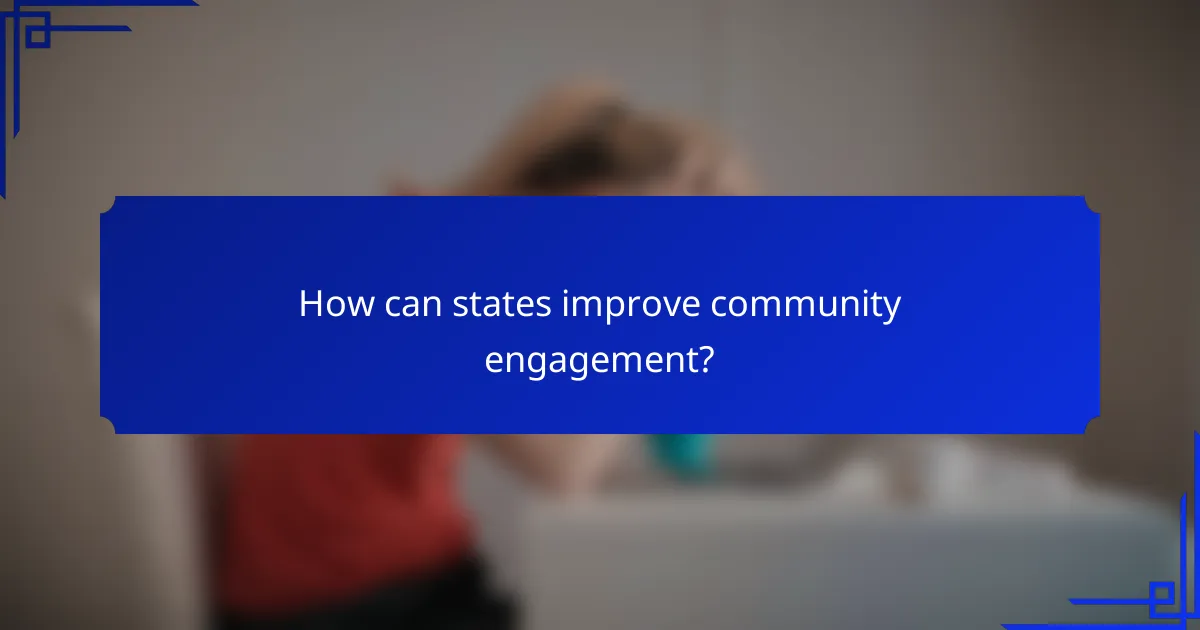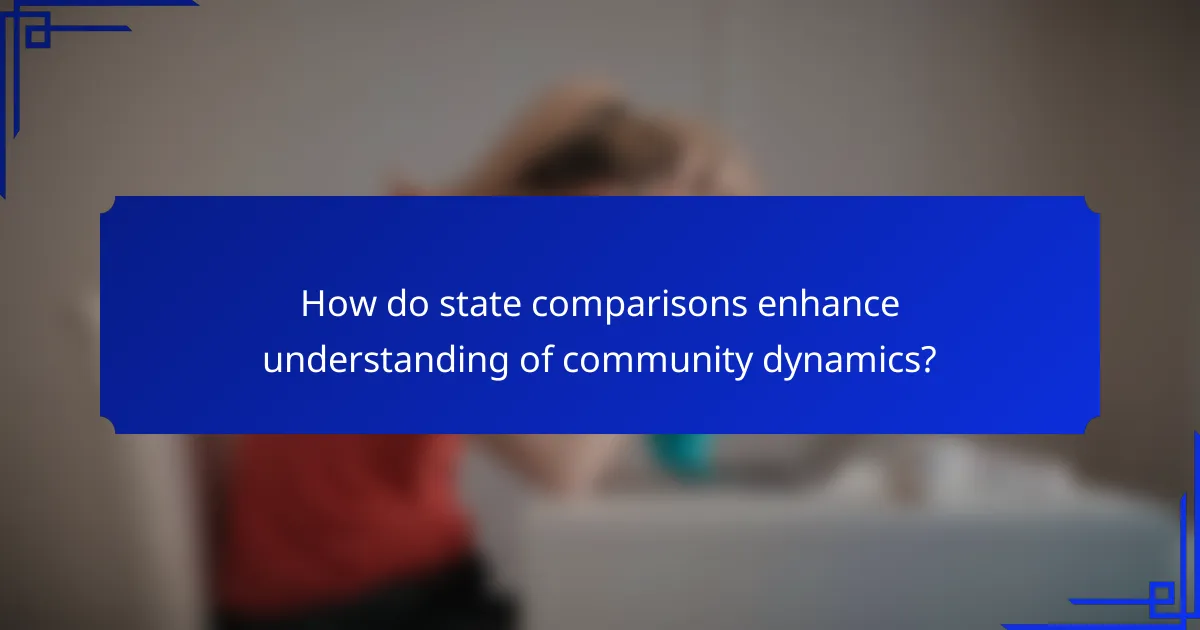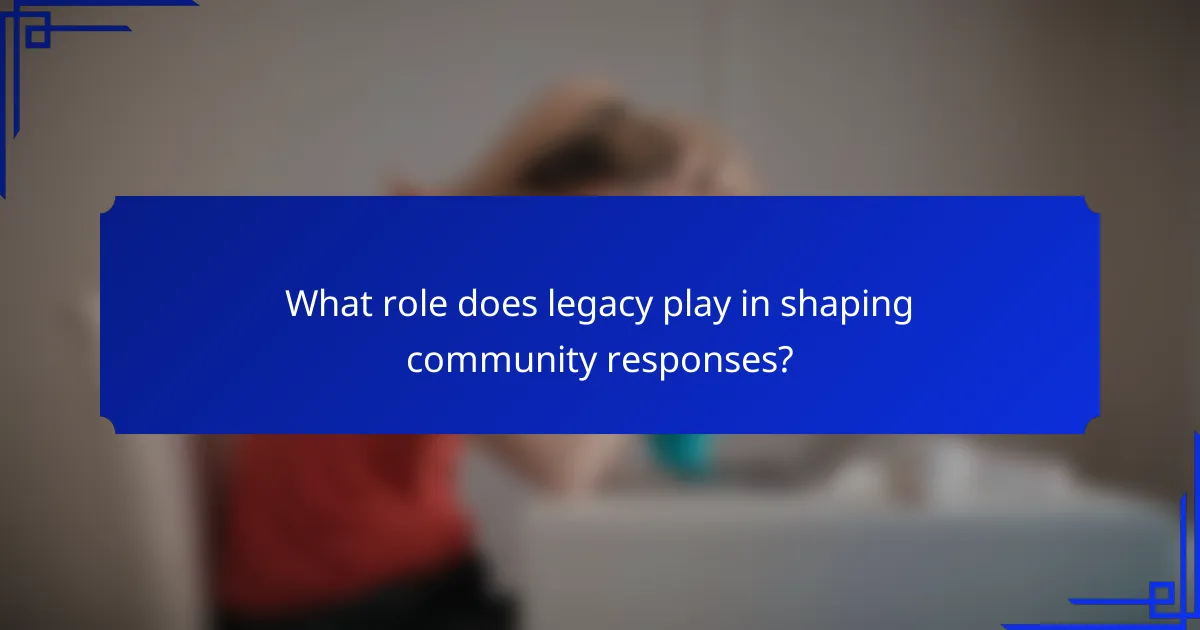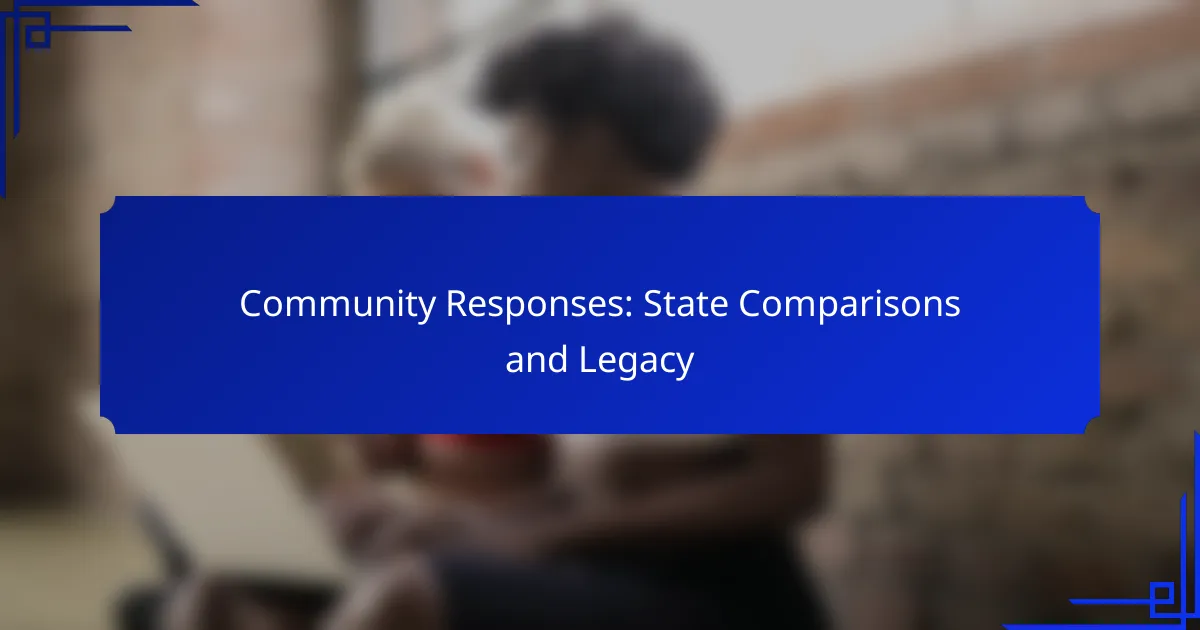Community responses to issues vary widely across states, influenced by distinct cultural, economic, and political contexts. These variations shape how communities engage with challenges, resulting in diverse strategies and outcomes. By recognizing the factors that drive these differences, stakeholders can develop tailored approaches to enhance engagement and support within their communities.

How do community responses vary across states?
Community responses can differ significantly across states due to varying cultural, economic, and political landscapes. These differences impact how communities engage with issues, leading to diverse approaches and outcomes.
Variations in public sentiment
Public sentiment towards community issues often reflects local values and priorities. For instance, states with a strong emphasis on environmental conservation may see higher community activism around sustainability initiatives, while those focused on economic growth might prioritize business development over environmental concerns.
Additionally, demographic factors such as age, education level, and income can influence public sentiment. Younger populations may advocate for progressive policies, while older demographics might prefer traditional approaches, leading to contrasting community responses.
Differences in policy impacts
Policies enacted at the state level can significantly shape community responses. For example, states that implement robust social welfare programs may experience higher community engagement in support services, while those with limited support may see increased grassroots organizing to fill the gaps.
Moreover, regulatory environments can affect how communities respond to issues like housing or healthcare. States with stringent housing regulations might face community pushback, while those with more lenient policies could see rapid development but potential neglect of community needs.
State-specific case studies
In California, community responses to climate change have led to innovative local initiatives, such as community gardens and renewable energy projects, reflecting the state’s progressive stance on environmental issues. Conversely, Texas communities may focus more on economic development, leading to responses that prioritize job creation over environmental regulations.
In the Midwest, states like Michigan have seen communities rally around revitalization efforts in urban areas, showcasing a response to economic decline. Meanwhile, rural communities in states like Nebraska may prioritize agricultural policies, leading to different forms of community engagement and response strategies.

What are the key factors influencing community responses?
Community responses are shaped by various factors including demographics, economic conditions, and cultural differences. Understanding these influences can help in tailoring effective strategies for engagement and support.
Demographic influences
Demographic factors such as age, gender, and education level significantly affect community responses. For example, younger populations may be more inclined to engage in digital activism, while older demographics might prefer traditional forms of communication.
Additionally, the diversity within a community can lead to varied responses based on different needs and priorities. Communities with a higher percentage of immigrants may prioritize integration and language services, while more homogenous communities might focus on local issues.
Economic conditions
The economic landscape of a community plays a crucial role in shaping responses. Areas with high unemployment rates may see increased demand for social services and community support initiatives. Conversely, wealthier communities might focus on philanthropic efforts and volunteerism.
Economic stability can also influence the availability of resources for community projects. In regions with limited funding, grassroots movements may emerge to fill the gaps, while affluent areas might have more structured programs and initiatives.
Cultural differences
Cultural backgrounds impact how communities respond to various issues. For instance, communities with strong traditions may prioritize preserving cultural heritage, while others may focus on innovation and modernization. This can affect participation in community events and initiatives.
Moreover, cultural norms can dictate the preferred methods of communication and engagement. Understanding these nuances is essential for effectively reaching out and mobilizing community members.

How can states improve community engagement?
States can enhance community engagement by fostering inclusive participation, ensuring transparency, and creating accessible platforms for dialogue. By prioritizing these elements, governments can build trust and encourage active involvement from their citizens.
Best practices for outreach
Effective outreach involves identifying key community stakeholders and tailoring messages to resonate with diverse groups. States should utilize a mix of traditional and modern outreach methods, such as town hall meetings, newsletters, and social media campaigns, to reach a broader audience.
Regularly soliciting feedback through surveys or focus groups can help gauge community interests and concerns. This two-way communication fosters a sense of ownership and encourages ongoing participation.
Effective communication strategies
Clear and concise communication is essential for engaging communities. States should prioritize transparency by providing straightforward information about policies, initiatives, and opportunities for involvement.
Utilizing plain language and avoiding jargon can make information more accessible. Additionally, employing storytelling techniques can help illustrate the impact of community engagement, making it more relatable and compelling.
Utilizing technology for engagement
Technology can significantly enhance community engagement by providing platforms for interaction and information sharing. States should consider using mobile apps, online forums, and social media to facilitate discussions and gather feedback efficiently.
Moreover, virtual town halls and webinars can reach those unable to attend in-person events, ensuring broader participation. Leveraging data analytics can also help identify trends and preferences within the community, allowing for more targeted engagement efforts.

What are the historical trends in community responses?
Historical trends in community responses reveal how public sentiment and actions have evolved over time, often influenced by social, political, and economic factors. Understanding these trends helps identify patterns in community engagement and policy changes.
Evolution of public opinion
Public opinion has shifted significantly over the decades, often reflecting broader societal changes. For instance, attitudes towards environmental issues have become more favorable, with increasing support for sustainability initiatives and climate action.
Surveys indicate that community responses to social justice movements have also evolved, with greater awareness and activism in recent years. This shift is often driven by grassroots campaigns and the influence of social media, which amplify diverse voices.
Impact of major events
Major events such as economic crises, natural disasters, and social movements have a profound impact on community responses. For example, the COVID-19 pandemic prompted widespread community support initiatives, including food drives and mental health resources.
Similarly, events like the Black Lives Matter protests have galvanized public opinion and led to increased advocacy for policy reforms. These events often serve as catalysts for change, prompting communities to reassess their priorities and values.
Long-term changes in policy
Long-term changes in policy often stem from sustained community responses to pressing issues. For instance, increased public demand for affordable housing has led many cities to implement rent control measures and housing assistance programs.
Additionally, shifts in public health policy, such as the expansion of healthcare access, can be traced back to community advocacy efforts. These changes highlight the importance of ongoing engagement and the need for communities to remain active in shaping their governance.

How do state comparisons enhance understanding of community dynamics?
State comparisons provide valuable insights into community dynamics by highlighting variations in responses to similar challenges. By examining how different states address issues like public health, education, and economic development, stakeholders can identify effective strategies and areas for improvement.
Benchmarking community responses
Benchmarking community responses involves evaluating how different states tackle similar problems, such as disaster recovery or social services. This process allows communities to assess their performance against others, identifying strengths and weaknesses. For example, a state that effectively reduced homelessness may serve as a model for others struggling with similar issues.
Communities can use key performance indicators (KPIs) like response times, resource allocation, and community engagement levels to benchmark their efforts. Regularly updating these benchmarks ensures that communities remain competitive and responsive to changing needs.
Identifying successful models
Identifying successful models requires analyzing the practices of states that have effectively addressed specific community challenges. For instance, states with robust mental health programs can provide insights into funding strategies and service delivery methods that lead to better outcomes. By studying these models, other states can adapt and implement similar strategies tailored to their unique contexts.
Collaboration among states can facilitate the sharing of best practices. Conferences and workshops can be organized to discuss successful initiatives, allowing states to learn from each other’s experiences and avoid common pitfalls.
Lessons learned from state comparisons
Lessons learned from state comparisons often reveal critical insights into what works and what doesn’t in community dynamics. For example, states that prioritize community involvement in decision-making tend to achieve better engagement and satisfaction levels. This highlights the importance of inclusive processes in developing effective policies.
Additionally, understanding the impact of local regulations and funding mechanisms can inform future initiatives. States that have successfully navigated funding challenges often share strategies that can help others optimize their resources and improve service delivery.

What role does legacy play in shaping community responses?
Legacy significantly influences community responses by establishing a framework of values, traditions, and historical experiences that guide collective actions. Communities often draw upon their past to inform current decisions, shaping their responses to contemporary challenges.
Historical context of community actions
The historical context of community actions reveals how past events shape present-day responses. For instance, communities affected by natural disasters often develop resilience strategies based on previous experiences, leading to organized relief efforts and preparedness plans.
In many cases, historical injustices or successes can mobilize communities to act. For example, neighborhoods with a legacy of activism may respond more vigorously to social issues, leveraging their history to advocate for change and support one another.
Understanding this historical context is crucial for policymakers and community leaders. They can build on existing frameworks and foster collaboration by acknowledging past experiences, ensuring that responses are relevant and effective in addressing current needs.
